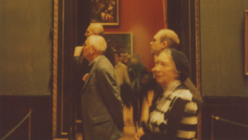The last two weeks of May 2013 were a wild and wooly time in the San Francisco arts community: two mammoth art fairs, MFA exhibitions highlighting the work of graduates from numerous regional institutions, and all the events leading up to the temporary closing of SFMOMA means there’s a lot to see. In the midst of that whirlwind, a pair of intimate exhibitions opened at SF Camerawork that consider, by different and fascinating means, the use and meaning of still imagery.
New York-based filmmaker and photographer Jem Cohen presents Museum Pictures, a project comprising a full-length film and the set of photographs on exhibit. Cohen filmed in locations around the world for more than two decades. In that time, he used photographs as notes, reminders of what he had seen and where he had been. In 2010, Cohen began working at the Kunsthistorisches Museum, Austria’s lauded state art museum. What emerged are two aesthetic moments — one cinematic, the other photographic — that share a common subject, but function independently of one another.
In the film, for which Cohen was awarded the Golden Gate Persistence of Vision Award at the 56th San Francisco International Film Festival last month, we watch a relationship develop between Johann and Anne. Their association, first as museum guard and visitor, respectively, and later as friends, begins in the museum but moves beyond the physical and psychological restraints of the building.

While the film has been described as the most narrative in Cohen’s body of work, the photographic series by comparison does not provide the same pay off. Rather, we see visitors captured in unscripted moments; standing, looking, some jockeying for space in front of very famous paintings. As often as not, Cohen photographed visitors in moments of boredom and rapturous appreciation of the objects before them. The dreary interior lighting and Cohen’s off-center compositions — including awkward, humorously incomplete fragments of paintings and sculptures — do not portray the best view of the museum’s treasures or of the people visiting. In fact, nothing in Cohen’s photographs is idealized, which is why they are compelling. Museum Pictures as a photographic series takes up the mundane details that are briefly visible in cinematic form, providing further commentary on the ever-changing relationship between photographic and filmic practice in contemporary art.



